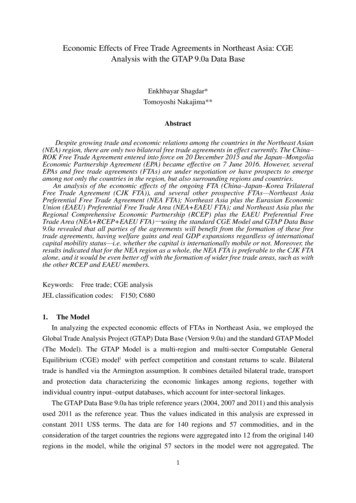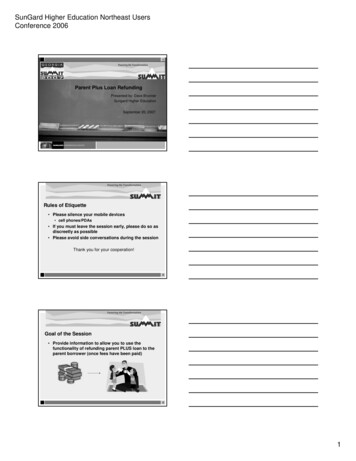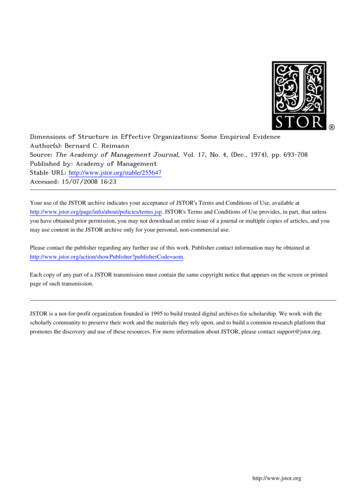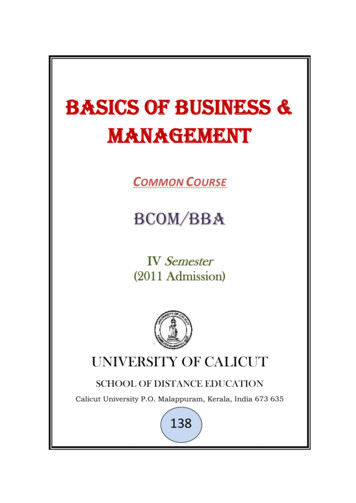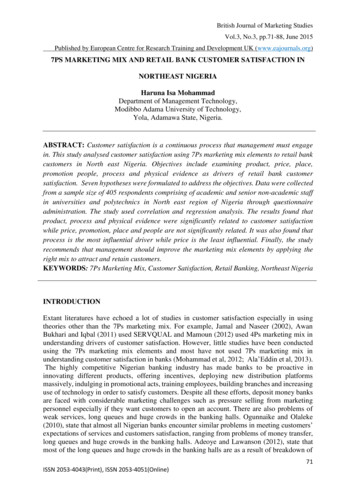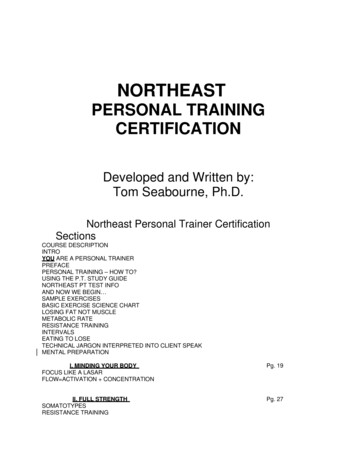
Transcription
NORTHEASTPERSONAL TRAININGCERTIFICATIONDeveloped and Written by:Tom Seabourne, Ph.D.Northeast Personal Trainer CertificationSectionsCOURSE DESCRIPTIONINTROYOU ARE A PERSONAL TRAINERPREFACEPERSONAL TRAINING – HOW TO?USING THE P.T. STUDY GUIDENORTHEAST PT TEST INFOAND NOW WE BEGIN SAMPLE EXERCISESBASIC EXERCISE SCIENCE CHARTLOSING FAT NOT MUSCLEMETABOLIC RATERESISTANCE TRAININGINTERVALSEATING TO LOSETECHNICAL JARGON INTERPRETED INTO CLIENT SPEAKMENTAL PREPARATIONI. MINDING YOUR BODYFOCUS LIKE A LASARFLOW ACTIVATION CONCENTRATIONPg. 19II. FULL STRENGTHSOMATOTYPESRESISTANCE TRAININGPg. 27
PRACTICAL TOPICAL TRAINING TIPSARE YOU FAST OR SLOW TWITCH?MUSCLE & METABOLISMTHE WARM-UPCORE REMINDERS60 IS THE NEW 40OLDER ADULT RESISTANCE TRAINING TIPSPg. 51III.EAT TO LOSE FAT AND GAIN MUSCLESTARVE YOUR FATKNOWING WHAT TO DO AND DOING ITDID YOUR CLIENT GO WRONG?PALEO, ATKINS ?CARBS & PROTEININTERMITTENT FASTINGEATING FOR HEALTHSCATTERSHOOTING DIET TIPSREFUELINGERGOGENIC AIDSMETABOLISM 101Pg. 85IV. CARDIO TRAININGINTERVALSMEDICINE BALL TRAININGSTABILITY BALL TRAININGPLYOMETRIC POWER TRAININGV. PRE-HAB AND RE-HABSTRONG CORELOW BACKELBOWSHOULDER HEEL KNEEANKLEVI. POWEREXPLOSIVE MOVESCOOL-DOWNVII. FLEXIBLE MOVESAPPENDIX A. AUTHOR BIOAPPENDIX B: BIBLIOGRAPHYAPPENDIX C: ASSESSMENTSAPPENDIX D: Q & AAPPENDIX E: GLOSSARYAPPENDIX F: WHAT THE LAW SAYSAPPENDIX G: SAMPLE CONSENT FORMAPPENDIX H: HEALTH HISTORY FORMAPPENDIX I: LEADERSHIP AND PROFESSIONALISM FORMPg. 104Pg. 131Pg. 138
ACKNOWLEDGEMENTSI would like to thank SCW. Exercise Etc. and IDEA for preparing me to guide my studentson their first step towards a personal training career. Our goal is to point candidates tocontinued success in their plans to become certified through the American Council onExercise (ACE), the American College of Sports Medicine (ACSM), and/or as a CertifiedStrength and Conditioning Specialist (CSCS).Course Description:The Northeast Personal Training Certification is a combination of academic study with thelatest practical research. This course is a comprehensive program designed to provideyou with all of the skills required to become a personal trainer. Learn cutting-edgeinformation on exercise science, flexibility, resistance training, nutrition, mind/bodyexercises, and cardio workouts. Experience sports performance enhancement drills andprogram development techniques. To become a Certified Personal Trainer, you mustreceive a passing score on the written and practical exam following your course of study.Retesting options are available.
INTROYour client’s high school P.E. teacher taught her to hate push-ups and sit ups, and running waspunishment. So, now you are her personal trainer and you want to make exercise fun.You can change your client’s life. Here’s how. You coach your client through her workouts. Youchat with her during her warm up on the treadmill. Then you pace her through her strength trainingand cardiovascular workouts. But that’s not all. You advise your client on her eating, sleeping andstress management.YOU ARE A PERSONAL TRAINERMotivator: The Jack LaLanne of exercise physiology won’t help your clients reach their fitnessgoals unless he is also the Tony Robbins of motivation.Human: You might think your client would benefit from the drill approach. That commandantstyle wears thin after about a week. Be a trainer who is informed, genuine and warm.Communicator/Teacher: If you are a dictator, my-way-or-the-highway personal trainer, you cando better. Listen to your client’s goals and effectively teach her how to reach them.Professional: Is “hurry up and wait” a part of your way of teaching? Do you finish with a client,change your clothes in a flurry, and apologize profusely to your next client because you are in themiddle of your “leg day” workout.Think of yourself as a school teacher. Eventually, your client doesn’t need you. Good personaltrainers wean clients toward personal responsibility. They teach clients to work out safely andeffectively. A “check-up” is advisable from time to time to tweak their form and to upgrade theirprogram. Unless you are a baby sitter or a paid conversationalist, however, personal training is ashort-term arrangement.PREFACENortheast Personal Training teaches you:Training techniques to improve your client’s fitness performance.The risks and injuries associated with your client’s sport/fitness.Prevention and treatment of your client’s fitness related injuries.Eating programs to fuel your client’s muscles.Flexibility and cardiovascular training workouts.Strength training to speed metabolism and gain muscle.Mind/Body strategies for motivation and exercise adherence.Programming for peak athletic performance.
USING THE P.T. STUDY GUIDEThere are many ways to use this guide. Scan a few pages here and there, read itfrom A to Z, or even memorize and recite the entire text aloud. It works well as areference aide!Cover-To-Cover: Read every page of the Personal Training Manual and you willfind yourself to be the most popular personal trainer in your neighborhood. Newfoundbuddies will ask you to treat their plantar fascitis or they will quiz you on the pros and consof whether they should wear a knee brace. Be careful! Although your brain will be asfull as a medical encyclopedia, for liability reasons, always suggest your friends andclients consult their physicians before using your exercise program.Read What You Need: The method is simple. Choose your favorite section of thePersonal Training manual. Begin reading, but set your alarm to buzz at twenty minutesintervals. No matter how engrossed you are in the book, stand up for two minutesbetween every twenty-minute reading session, and physically perform one of theprograms you just read about. Then sit yourself back down and flip through more pagesuntil another topic excites you. Repeat this cycle until your brain is full and your body is arole model for your clients.Your Responsibility: It’s fundamental, primary, and paramount that each futurepersonal trainer certified through this course develops a basic, functional understandingof kinesiology and anatomy. While we do not spend time in this course memorizingtopics like joint actions, for example, such as the “biceps do elbow flexion,” it’s importantto realize that this is your responsibility as a personal trainer. The videos and website“exercise” section contain general information such as bones, muscles, and other usefulinformation that only will enhance your success in this certification.Study Guide OrganizationThis guide has several different sections and a glossary. Feel free to pinball frompart to part at your leisure. No section depends on another. If you are interested in
knee problems, you may shy away from the stretching section. You might be surprisedto discover that if your client needs to improve her hamstring flexibility, and she performsthe hamstring stretches you suggest, her back pains suddenly disappear. And guess onwho is the hero?Simple, step-by-step drills, exercises, and techniques will provide your client withTHE EDGE. If your client uses these strategies to become stronger, fitter, have morecoordination, endurance, and flexibility then she will improve her health and performance.Your client is an athlete, treat her as one.NORTHEAST P.T. TEST INFO:The written examination will consist of multiple-choice and true-false questions.Certification candidates must achieve a passing score of 85%.The written examination covers all materials contained in the videos, power pointpresentations, “Exercise” section, Dr. Tom’s blogs, and this study guide. It requires thatyou have a general understanding of the practical skills and theoretical material forteaching exercise technique.The details of the practical exam are explained onsite unless you are taking thecourse online. The online practical exam requires that you send us a video of you“showing-telling-doing” three exercise routines.Examinees attending a certification program who do not pass the written and/orpractical examination will have retest options available.RETESTINGNortheast will attempt to accommodate those individuals who do not pass thewritten and/or practical examinations who wish to retest.Candidates can retest thewritten and/or practical examination for Northeast Certifications program within 60 days oforiginally participating in the certification program. Our primary goal is that certificationcandidates are successful in this learning process. Therefore, it is our sincere desire tomake this testing process successful for everyone. We will attempt to accommodatespecial needs and learning disabilities to the best of our abilities. Please call us inadvance of the certification program at 903-575-8914 to discuss any specialarrangements that you may require, or inform your instructor.
NOW WE BEGIN .Change the way your client moves and thinks. Take normal activities in and out of thegym, and transform them into flab-burning fun. The videos and study guide will provideyou with recipes to follow. At the same time, your client will learn what to eat to fuel hermuscles and starve fat cells.Start a mind/body journey to help your client reach her goals. Weave together asensible eating plan, do-able activity, and the mental strategies your client will need toreach her genetic potential. Start off easy, and then as your client gets fitter andstronger, keep your client’s workout challenging and productive.Maybe you never thought of yourself as a physiologist or diagnostician. But PersonalTraining helps you to recognize your client’s common fitness injuries and how to treatthem. You will learn just enough about anatomy and first aid so you won’t be confused.You will amaze your clients with your knowledge about the shoulder, knee, back, and abs.But no matter what, always remember to tell your client to consult her physician.Have you harbored a secret desire to phone the American Red Cross, to find outthe percentage of heart attack victims who are actually revived by CPR? Or would you be
curious to know what percent fat you’re allowed to eat on the Pritikin Diet? The badnews is, the answer to both of these questions is roughly fifteen percent. Maybe thePritikin Diet IS too stringent for your average client. But mind/body strategies will benefityour client no matter what her fitness goal. Teach your client to relax, focus, and be herbest in any situation she can imagine. But take a guess what the #1 fitness goal most ofyour clients will ask for - LOSE WEIGHT!GO TO: www.ntcc.edu/personaltrainingCLICK ON “EXERCISES”YOU WILL BE DIRECTED TO A FULL-BODY FRONT AND BACK ANATOMY CHARTUSE YOUR CURSOR TO CLICK ON A MUSCLE GROUPTHERE YOU WILL BE ABLE TO LEARN HOW TO TRAIN EACH MUSCLE GROUP INEVEN GREATER DETAIL THAN THE CHART BELOWSample Exercises andBasic EXERCISE SCIENCEExerciseSquatLungeMuscle Group andJoint ActionsQuadriceps,hamstrings andgluteals.Hip flexion andKnee extensionQuadriceps,Execution and AlignmentFeet wider than shouldersAbdominals contractedSquat downKnees do not pass the toesKnees do not flex beyond90 degreesWeight stays on the heelsStart in split lunge position
Hamstring andGlutealsHip flexion andKnee extensionLunge straight downFront knee stays over ankleBack knee stays under thehipStanding and Hip extensionProne legand knee flexionExtensions andHamstrings andCurlsGlutealsStand in proper standingalignment, keep thesupporting knee softRaise leg behind being sureNot to arch the back Bendthe knee by curling Heeltoward the buttocks Or, lieface down in pronePositionPerform slight posteriorPelvis tilt to insure neutralSpinal alignmentFront raisesDeltoidsShoulder jointFlexionStand in proper standingalignment w/ knees softKeep elbows slightly bentRaise to shoulder levelLateral raisesDeltoidsShoulder jointAbductionSame as aboveRaise arms out to sideBicep curlsBicepElbow flexionStand in proper standingalignment w/ knees softHold elbows close to bodyAnd curl hands towardShouldersTricepExtensionsTricepsElbow extensionStand in proper standingalignment w/ knees softRaise arms overheadBend elbows and placeThem close to the templesRowsTrapezius,Rhomboids andStand in split lunge positionand flex forward at the hips
Latissimus DorsiShoulder girdleAdductionShoulder jointExtensionFor trapezius, lift theelbows up and out bypulling the shoulder bladestogether toward the spineFor Latissimus Dorsi, pull theArms toward the bodyKeeping the elbows closeTo the body and palmsFacing each otherCan also be done whileKneeling and on unilaterallyOn hands and kneesPush-upsPectorals andTricepsShoulder girdleAbductionElbow extensionOn hands and knees orhands and toesAbdominals contractedHead in line w/ spineLower body down and upAbdominalCurlsRectus abdominusInternal and externalObliquesSpinal flexionSpinal rotationLie on back w/ spine inneutral alignmentCurl up to center, liftingThe shoulder blades offThe floor and slowly lowerFor the obliques, rotate theSpine by lifting shoulderToward opposite kneeProneExtensionErector spinaeSpinal extensionIn the prone position,lift head and one or bothArms off the floor byExtending the spine. CanAlso lift one leg at a timeSummary: The Shoulder and the Shoulder GirdleShoulderanterior deltoidshoulder flexionmiddle deltoidarm abductionposterior deltoidshoulderextension
Shoulder Girdle: the Scapulaeuppermid trap. & er trap.anterior serratusdepressionabduction/protraction
LOSING FAT, NOT MUSCLENo doubt your client has dabbled in the so-called magic bullets of weight loss.From infomercial products to the latest diet fads, she has probably sampled them all. Bynow she realizes that quick weight loss causes quicker weight gain; and that losing weightis really about progress and not perfection.It is dinnertime and decision time. Should she check the refrigerator and throwsomething together, or follow a recipe? Toss whatever into a bowl and stir, or go for a surething? It is the same question with losing fat. The ingredients are weight training, cardioand eating. You know the mix. You read all of the magazines, but the informationchanges. You assumed your client was on the right program, but the pounds remain.“Those who say they will work out later in the day find other things to do”, says KarenWest, Fitness Director for the Santa Clarita Athletic Clubs in California. So make ithappen at dawn. Have your client sound her alarm 35 minutes early and follow these 10steps to a smaller waistline:1. Her alarm sounds.2. She hits the snooze button, lies back and imagines her workout.3. Next the obligatory morning visit to the restroom.4. She gets dressed in workout clothes that she set out the night before.5. Ready to warm up.6. Monday, Thursday and Sunday strength train (see Strength Training).7. Tuesday, Friday and the following Monday cardio (see Interval Training).8. She rewards herself with a hearty breakfast.9. Time for a shower.10. Seize the day.METABOLIC RATE“Between the ages of 30 and 70, your client’s fat free mass (muscle) declines byabout 40%” according to Len Kravitz, Ph.D., assistant professor of exercise science at theUniversity of New Mexico in Albuquerque. Muscle loss is thought to be the single mostimportant reason your client stores more fat as she ages. The loss of muscle and resultingmetabolic slow down makes her susceptible to gaining fat.Each pound of muscle burns approximately nine calories a day. “A loss of just ½pound of muscle (25 calories expended daily), could theoretically cause your client togain 2.6 pounds of fat in a year” warns Jeannie Patton, MS exercise physiologist based inCleveland, OH. Ten years later she looks in the mirror and sees herself 26 poundsheavier. In 20 years, she added 52 pounds to her frame. And in 30 years, she could be awhopping 78 pounds fatter without eating additional calories, says Patton.Several metabolic factors determine your client’s caloric expenditure. If she istaller, she burns more calories than a shorter person does. The harder she works out themore calories she fries. If it is extremely cold or hot, her body uses extra calories tomaintain normal temperature. And “if she is fit, she fritters away more calories than a
sedentary person does”, says Patton.“There is no better way to increase your metabolism” than lifting weights says DanKosich, president of EXERFIT Lifestyle Consulting in Denver, CO. If your client decides toweight train at home she needs a bench and several sets of dumbbells. A mirror can helpher keep her form, and music may provide motivation.RESISTANCE TRAININGTo learn the exercises and get your client accustomed to the weights, have her doa full-body workout every third day. Have her perform one set of 10 reps for each musclegroup at a weight she can comfortably handle for all 10 reps.Tips on Resistance Training1. Perform each exercise through the full range of motion.2. Exhale on the exertion phase of each movement.3. Relax muscle groups that are not involved in the lift.4. Perform each exercise with neutral spine in alignment with the rest of the body.5. Move mindfully and slowly, never jerking or bouncing the weight.INTERVALSInterval training should refer to the manipulation of exercise intensity. Anaerobicinterval training involves the manipulation of exercise intensity that fuses anaerobicbouts of energy with aerobic recovery periods of easier intensity. Unfortunately,interval training is often misquoted and confused with circuit training. Circuit traininginvolves the manipulation of modes, or types of exercise.“For your client to receive the greatest value from her training, she should strive tobecome as fit as she can, so she burns more calories from fat at rest, and utilizes morestorage fat during her training” recommends Scott Cole, co-author of Athletic Abs (HumanKinetics).“To get fit, improve your client’s sports performance and accelerate fat loss tryinterval training,” suggests Joseph Signorile, Ph.D., assistant professor of exercisescience at the University of Miami in Florida. “Your client can burn more calories in ashorter period and it’s more fun than pounding the pavement” he says. Interval training isinterspersing work-efforts with recovery cycles. Have your client start slow and progressgradually to prevent injury. If she becomes injured she can’t train. And if she can’t train,she can’t lose the weight.Your client can interval train on a bike, stationary cycle, stair climbing machine,heavy bag, treadmill, or walking/jogging around her own backyard. All she needs is a pairof running or cross-training shoes, her exercise machine of choice (not required), herbody, and a timepiece. Have her do intervals every third day. For example, Tuesday,Friday, and Monday. Why? Because she is working hard and her body needs to recover,contends Karen West, who has been in the fitness industry for 17 years and is certified bythe American College of Sports Medicine.
WORKOUT PROGRAM (1)Weeks 1-5 SpeedworkAfter a five-minute warm-up, have your client do a 15-second work interval at an intensitywhere she is huffing and puffing. Take 45 seconds for her to recover at a “walking pace”.Continue this cycle until you she has accomplished 12 work intervals and 12 recoveryintervals (or 12 minutes of training). Now she can cool down with five minutes at an easypace. Take a few moments for her to stretch, and don’t forget to remind her to eatbreakfast.Each week, have your client add two cycles to her training. By week five she should bedoing 20 work intervals and 20 recovery intervals. Be sure she cools down and stretches.Workout Program (2)Weeks 6-7: PyramidsYou may have heard of pyramid training with weights. For more information, consultchapters 10 and 11 of Effective Strength Training. Try to “pyramid” your client’s intervals.After her five-minute warm up, have her perform fast-paced intervals followed by15-second active recovery periods. Begin with a 15-second effort interval. Recover. Gearup for a 30-second effort interval. Recover. Next focus on a 45-second effort. Recover.Now power through a full-minute gut-busting interval! Recover. Come down the pyramidwith a 45-second effort interval. Recover. Next, 30-seconds of effort. Recover. Finally herlast 15 seconds; ask her to give it all she’s got. Recover for 15 seconds. Done! Cool down,stretch, shower, and eat.Workout Program (3)Weeks 8 and beyond: SpeedplayBegin with her warm-up. She picks up her speed. Faster! Then she slows down. Ask herto pick up the pace when she is ready. Tell her to listen to her body. Don’t push her toohard. Ask her to enjoy it. When 30 minutes is up, ask her to cool down, stretch, showerand eat.EAT TO LOSE“It is better to be disciplined about your eating than fanatical,” says Pam Neff, RD,
and Director of the Weight Management Center at the Internal Medicine Outpatient Clinicin Dallas, TX. Fueling your muscle is a major part of your weight loss. What you eat todayand tomorrow will benefit your workouts the next day, and the next. “You may burnbetween 300 - 500 calories per workout”, says Andre Houle, the co-owner of INSHAPEAT ANDRE’S in San Francisco, CA. Therefore, be sure your client is consuming enoughfood to maintain her hard-earned muscle. “Your workouts are more productive when youstoke your muscles with carbohydrates and protein”, says Ed Burke, director of theexercise science program at the University of Colorado at Colorado Springs. By the term“stoke your muscles,” he means “fuel.” Balancing your meals energizes your workouts.Choose morsels that feed your muscle, like nutrient-rich foods instead of nutrient-lackingfoods. Eat and drink just enough to satisfy.“People should experiment to find what works best for them and their particularlifestyle. However, I believe that everyone should eat a minimum of 3 meals a day, as thishelps boost metabolic rate and minimizes large surges in insulin and incoming fuels” saysSandra Woodruff, RD, based in Tallahassee, FL. Use a variety of mid-meal snacks to fillin the gaps.Your client should eat a combination of carbohydrates (starches and vegetables)and protein (lean meat, fish or dairy) at each meal. How much carbohydrates and protein?Nancy Clark recommends “about 60% of your calories from carbohydrates, about 15%from protein, and about 25% (maximum) from fat for most people.“Consume supplements in addition to, not in replacement of a well balanced eatingprogram”, says Ginger Patterson, Ph.D., RD, Nutrition Supervisor for Lee MemorialHospital in Fort Myers, FL. A mid-morning meal-replacement shake helps stabilize yourblood sugar so you will not be ravenous at lunch. Keep your client on a tolerable eatingand exercise program all of the time rather than depriving her and then watching her do afood fling. Supplements should only be recommended by Registered Dieticians, however,and should not be specifically advocated by personal trainers.“Weight training, intervals and eating correctly is a multi-level process that yourclient can enjoy without cluttering her life with deprivation diets, mysteriousphysique-enhancing supplements, and panicked scale-watching bouts of depression”says Cole. With all of that negativity behind her, she can begin to feel and inherentlyunderstand the benefits of healthy eating and exercise. Fear based fitness has no placein her program.
TECHNICAL JARGON INTERPRETED INTO CLIENT SPEAK*A muscle cell weighs more than a fat cell, but a fat cell is almost five times larger thana muscle cell.*Train according to your “perceived exertion”. Perceived exertion is a measure of howhard you are training based on how you feel.*Excess Post Exercise Oxygen Consumption (EPOC) is the afterburn – the amount ofcalories your body continues to burn after you have completed your workout.*Choose the upper body routine that works for you. Push one day, pull the next. Or, trychest, back and shoulders one day and arms the next day. When you stop makingprogress, it’ time to change your program.*Do not stretch your working muscles vigorously between sets. Instead, use that timeto mentally prepare for your next set.*Fast twitch, type IIB fibers are white, powerful, and larger than the slow twitch type I,red endurance fibers.*Balancing the size and strength between your thighs and hamstrings not only keepsyour legs looking great but it protects the stability of your knees.*Firm those buns all day long. Whenever you are about to sit, stand, stoop, or benddown, lead with your buns and keep your back straight.*Lifting weights tightens, trims and firms muscle. And no worries of developing "a bigbutt". If you train properly, you actually lose inches.*Partner training is great for your motivation. Choose a reliable partner.*When someone watches you work out, it gives you extra pep to get a couple of extrareps. Be careful not to lose your form.*Just by thinking about doing your leg workout your heart rate may increase by asmuch as 50 percent.*Visuo-motor behavior rehearsal (VMBR) is a combination of using relaxation andimagery to improve athletic performance.*Pause at the bottom of each rep when you do squats, lunges, and dead lifts and youwill recruit more muscle fibers from you buns.*Basal metabolic rate (BMR) is the number of calories your body burns at rest. About25 percent of your BMR is based on how much muscle you have.
*Everybody is different concerning how far they can safely descend for squats, lungesand dead lifts. It depends on limb and torso length and flexibility.*Your gluteus maximus (glutes) refers to your buns while your quadriceps (quads) arethe four large muscles on the front of your thigh.*Train your thighs and hamstrings equally to prevent a muscle imbalance which couldcause a knee injury.*Resistance training is the best tool to reshape your buns and thighs. Cardio is secondbest.*The side of your hips (saddlebags) known as your gluteus medius balances yourmovement when you walk or do lunges and squats.*Between sets of leg exercises stand up and move around occasionally get the kinksout and to speed the circulation in your lower body.*Your thighs are actually named quadriceps because they are made up of four musclesin the front of your leg.*Train both your fast and slow twitch thigh and bun muscles in the same week by doing10-12 reps one workout with lighter weight, and doing six to eight reps on your nextworkout with heavier weight.*Training your legs with weights is a full body exercise because many muscles in yourupper body are used to stabilize your movement.*Keeping your back straight really means maintaining a natural curve in your lowerback. This keeps your spinal disks healthy and prevents injury.*You may do easy activity and cardio every day. But weight training should be limitedto twice a week per muscle group.*Be careful not to develop an overuse injury. One of the greatest predictors of an acuteinjury is if you are suffering from a current injury.*Breathe from your belly (diaphragm). You can get more air into your lungs if youbelly-breathe.*Static stretching means to hold your stretch. Hold your stretch for between 15-30seconds to combat the stretch reflex.*If you improve your VO2max. you burn more total calories even at rest. YourVO2max. is how much oxygen your muscles use per minute during exercise.
*Never work out a sore muscle. Your muscles need to repair themselves during yourrest days. If they don’t get enough rest they will constantly be in a broken down state.*Most people think lactic acid is “the burn” you feel in your muscles during yourworkout. The burn is actually caused by hydrogen ions that increase the acidity in yourblood.I. MINDING YOUR BODY: MENTAL PREPARATIONActivationTake a good, hard look at your client. Do you consider her an athlete? Although herathleticism may be hidden under layers of fat or unused muscle, she is an athletenonetheless.Your client may not be Olympic caliber, but treat her like a futureOlympian. An Olympic athlete warms-up, works out, cools down and stretches just likeyour client. She improves her strength, flexibility, and endurance. An Olympian takes hertraining seriously. She mentally prepares for her training and your client should too! AnOlympic lifter or sprinter is totally focused on his goals. He does not waste energycontracting muscles unnecessarily. It is the same with your client. When he is hoistingweights or sprinting intervals on the treadmill, he should contract only the musclesneeded for lifting or sprinting.Learning to relax may be the single most important lesson your client canaccomplish (Weinberg, Seabourne, & Jackson, 1981). She already knows how to liedown on a cozy couch and watch television in a stupor, but this is not the type ofrelaxation we are referring to. Relaxation is recognizing his muscles are tense andspontaneously allowing them to relax (Jones & Hardy, 1989).Your client may perceive herself to be an expert in relaxation—or at least he thinksshe is. You notice her face and neck muscles are contracted during a bench press andyou suggest she relax, but her muscles remain stiff. When she attempts to relax, she isunsuccessful because she is trying too hard (Murphy, Woolfolk, & Budney, 1988).Here are some cues to help your client to relax:
Ask her to breathe slowly from her belly.Suggest she repeat calming words to herself such as “relax”.Remind her to focus on the proper cues for her activity.Tell her to slow down. There is no rush.Relaxation is, well relaxing, but there are times your client needs to get pumped up.In the Sydney Olympics, shot putters and weight lifters growled and snarled before,during and after their events. Activation is the act of getting excited, psyched and mentallyprepared. Activation is synonymous with the sports- psychology term arousal. Activationis not anxiety. Although anxiety involves increased arousal, anxiety grows from worry andnegative thoughts and feelings (Morgan & Pollack, 1977).To increase your client’s activation:Be sure he warm
The Northeast Personal Training Certification is a combination of academic study with the latest practical research. This course is a comprehenive programs designed to provide you with all of the skills r

